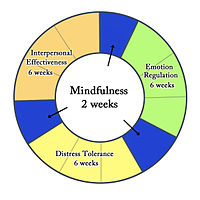
Photo from wikipedia
Abstract Background Dance/movement therapy (DMT) interventions have been used to support people with schizophrenia; however, these typically include lengthier interventions. Current inpatient hospitalization lengths of stay do not offer the… Click to show full abstract
Abstract Background Dance/movement therapy (DMT) interventions have been used to support people with schizophrenia; however, these typically include lengthier interventions. Current inpatient hospitalization lengths of stay do not offer the time needed to implement such interventions. The current treatment protocol for people in acute phases of schizophrenia is psychopharmacological; however, high rates of medication nonadherence and limited effects on negative symptomatology suggest the need for complementary psychosocial treatment options. The purpose of this study was to determine: feasibility of protocol completion, feasibility of measurement sensitivity, and the effects of a single-session DMT intervention compared to a single-session verbal treatment as usual (TAU) intervention. Methods This mixed methods feasibility study utilized a convergent mixed methods feasibility design. Qualitative and quantitative data were collected simultaneously in a single phase from the experimental and control groups. In this study, the quantitative strand was prioritized and constituted most of the data collection. A qualitative strand was added to enhance the understanding of participants’ experiences of the intervention and control conditions. Thirty-two participants were randomized to a 45-minute DMT session or a 45-minute verbal TAU session. Quantitative data were collected using the Brief Psychiatric Rating Scale, and qualitative data through semi-structured interviews. Results indicated that participants in the DMT intervention group had statistically significant symptom reduction versus those in the TAU group in overall BPRS scores (p < 0.001), Psychological Discomfort (p < 0.001), Negative Symptoms (p = 0.007), and Positive Symptoms (p = 0.003). No statistical significance was shown for Resistance. Qualitative findings substantiate the quantitative findings, however, show divergence regarding Resistance. Participants in the DMT group expressed feeling more in control, less angry, and motivated for continued treatment. Discussion These findings suggest that a single-session DMT intervention can alleviate symptoms associated with acute schizophrenia including affective regulation, and positive and negative symptomatology such as isolation, spontaneity, interpersonal skills, paranoia, and auditory hallucinations. Psychosocial interventions may be used in tandem with psychopharmacological interventions to support increased stabilization for patients experiencing acute phases of schizophrenia.
Journal Title: Schizophrenia Bulletin
Year Published: 2020
Link to full text (if available)
Share on Social Media: Sign Up to like & get
recommendations!